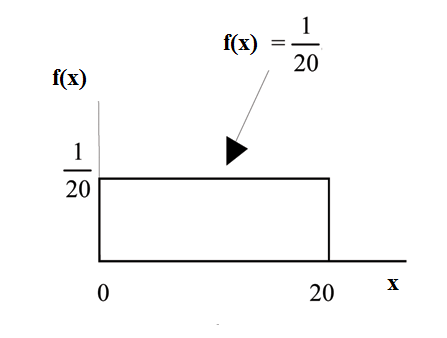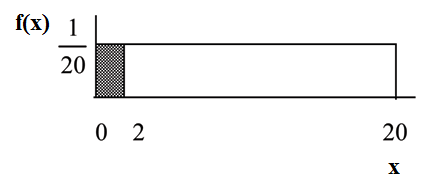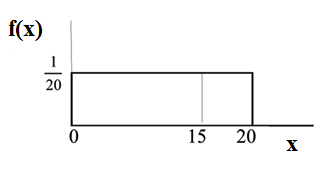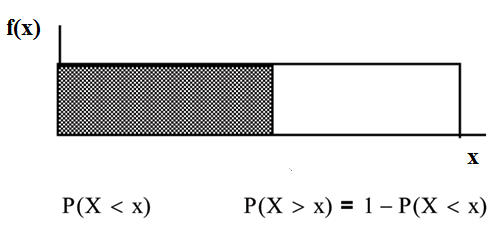Consider the function
 for
0≤x≤20.
x = a real number.
The graph of
for
0≤x≤20.
x = a real number.
The graph of
 is a horizontal line. However, since
0≤x≤20
,
f(x) is restricted to
the portion between x=0 and
x=20, inclusive .
is a horizontal line. However, since
0≤x≤20
,
f(x) is restricted to
the portion between x=0 and
x=20, inclusive .

 for
0≤x≤20.
for
0≤x≤20.
The graph of  is
a horizontal line segment
when
0≤x≤20.
is
a horizontal line segment
when
0≤x≤20.
The area between  where
0≤x≤20
and the x-axis is the area of a rectangle
with base = 20 and height =
where
0≤x≤20
and the x-axis is the area of a rectangle
with base = 20 and height = .
.

This particular function, where we have restricted x so that the area
between the function and the x-axis is 1, is an example of a continuous
probability density function. It is used as a tool to calculate
probabilities.
Suppose we want to find the area between  and the x-axis where 0<x<2
.
and the x-axis where 0<x<2
.


(2–0)=2= base of a rectangle
 = the height.
= the height.
The area corresponds to a probability. The probability that x is between 0 and 2 is 0.1, which can be written mathematically as P(0<x<2) =P(x<2)=0.1.
Suppose we want to find the area between  and the x-axis where 4<x<15
.
and the x-axis where 4<x<15
.


(15–4) = 11 = the base of a rectangle
 = the height.
= the height.
The area corresponds to the probability
P(4<x<15)=0.55.
Suppose we want to find P(x = 15). On an x-y graph, x = 15 is a vertical line. A vertical
line has no width (or 0 width). Therefore,  .
.

P(X≤x)
(can be written as
P(X<x)
for continuous distributions) is called the
cumulative distribution function or CDF. Notice the "less than or equal to" symbol. We
can use the CDF to calculate
P(X>x)
. The CDF gives "area to the left" and
P(X>x)
gives "area to the right." We calculate
P(X>x)
for continuous distributions as follows:
P(X>x)=1–P(X<x)
.

Label the graph with
f(x) and x.
Scale the x and y axes with the maximum x and y values.
 ,
0≤x≤20.
,
0≤x≤20.






























